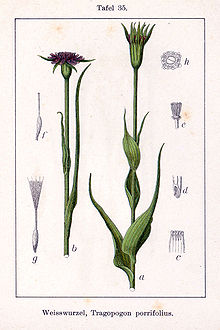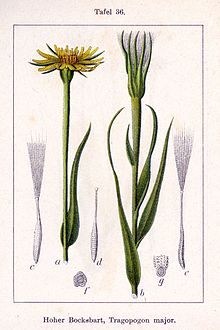Goatee
| Goatee | ||||||||||||
|---|---|---|---|---|---|---|---|---|---|---|---|---|

Meadow goat whiskers ( Tragopogon pratensis ) |
||||||||||||
| Systematics | ||||||||||||
|
||||||||||||
| Scientific name | ||||||||||||
| Tragopogon | ||||||||||||
| L. |
Tragopogon ( Tragopogon ) are a genus within the subfamily of Cichorioideae within the family of Compositae (Asteraceae). They colonize areas all over Eurasia and North Africa . Some species are invasive plants found around the world and some are used as wild vegetables ( wild goat whiskers ) and grown ( oat roots ).
description



Vegetative characteristics
The Tragopogon species are biennial to perennial herbaceous plants that reach heights of 15 to usually 50 to 150 centimeters. The stems are often branched. The sitting leaves are entire.
Generative characteristics
The flower heads stand individually at the branch ends. They contain 30 to 50 to 180 (or more) ray florets arranged in a row or rarely two rows. In most species, the dark to light brown achenes consist of a fruit-bearing body and a more or less long, thin beak. They develop a large, white to brownish fringe of hair or pappus as a flight parachute. The pappus is between 0.6 and 4 cm long, made of slightly fringed, feathery bristles.
Systematics
The genus Tragopogon was established by Carl von Linné in Species Plantarum in 1753 . As lectotype was Tragopogon porrifolius L. fixed. The genus Tragopogon belongs to the subtribe Scorzonerinae from the tribe Cichorieae in the subfamily Cichorioideae within the family Asteraceae (Asteraceae).

There are 100 to 150 species in the goat beard genus ( tragopogon ) (selection):
- Tragopogon acanthocarpus Boiss.
- Tragopogon albinervis Freyn & Sint. : It occurs in Turkey .
- Tragopogon altaicus S.A. Nikitin & Schischkin : It occurs in Russia , Mongolia , Kazakhstan and Xinjiang .
- Tragopogon anatolicus A.Duran & al. : It was first described in 2014 from Turkey.
- Tragopogon angustifolius Willd. : It occurs in Morocco , Spain , Andorra , France and Italy .
- Tragopogon armeniacus Kuth. : It only occurs in Armenia .
- Tragopogon aureus Boiss. : It occurs in Turkey.
- Tragopogon balcanicus Velen. : It occurs in Croatia , Serbia , Bosnia and Herzegovina , Montenegro , Albania , Bulgaria , Romania , Macedonia , Greece and in the European part of Turkey.
- Tragopogon bjelorussicus Artemczuk : It occurs in Belarus and Ukraine .
- Tragopogon bombycinus Gredilla : It occurs in Spain.
- Tragopogon borystenicus Artemczuk : It occurs in Romania and Ukraine.
- Tragopogon brevirostris DC. : It occurs in the Caucasus , Georgia and Azerbaijan .
- Tragopogon buphthalmoides (DC.) Boiss.
- Tragopogon capitatus S.A. Nikitin : It occurs in Kazakhstan , Kyrgyzstan , Uzbekistan , Tajikistan , Turkmenistan and Xinjiang .
- Tragopogon castellanus Leresche & Levier : It occurs in Spain.
- Tragopogon cazorlanus C.Díaz & Blanca : It occurs in Spain.
- Tragopogon charadzeae Kuth. : It occurs in Georgia.
- Tragopogon colchicus Albov : It occurs in Georgia.
- Tragopogon collinus DC.
- Tragopogon coloratus C.A.Mey.
- Tragopogon cretaceus S.A. Nikitin : It occurs in the European part of Russia.
- Tragopogon crocifolius L .: It occurs in Morocco , Algeria , Spain, Portugal , France, Italy and Sicily .
- Tragopogon dasyrhynchus Artemczuk : It occurs in the European part of Russia, in the Caucasus, in Ukraine and in the Crimea .
- Big goat beard ( Tragopogon dubius Scop. , Syn .: Tragopogon dubius subsp. Campestris (Besser) Hayek , Tragopogon major Jacq. )
- Tragopogon elatior Steven : It occurs in Ukraine.
- Tragopogon elongatus S.A. Nikitin : It occurs in Kazakhstan, Kyrgyzstan, Xinjiang and Qinghai .
- Tragopogon fibrosus Freyn & Sint. : It occurs in Turkey.
- Tragopogon filifolius Boiss. : It occurs in the Caucasus, Georgia, Azerbaijan and Armenia.
- Tragopogon floccosus Waldst. & Kit. : It occurs in Hungary , Serbia, Romania, Bulgaria and Ukraine.
- Tragopogon gorskianus Rchb. f. : This endemic occurs only in Lithuania .
- Tragopogon gracilis D.Don : It occurs in Kazakhstan, Kyrgyzstan, Tajikistan, Uzbekistan, Afghanistan , northern India , Nepal , Tibet and Xinjiang.
- Tragopogon graminifolius DC.
- Tragopogon heteropappus C.H. An : It is only found in Xinjiang.
- Tragopogon heterospermus Schweigg. : It occurs in Latvia , Lithuania and Kaliningrad .
- Tragopogon idae Kuth. : It occurs in Armenia.
- Tragopogon karjaginii Kuth. : It occurs in Azerbaijan.
- Tragopogon kemulariae Kuth.
- Tragopogon ketzkhovelii Kuth. : It occurs in Armenia and Georgia.
- Tragopogon kindingeri Adamović : It occurs in Macedonia.
- Tragopogon lainzii Suár.-Sant. & al. : It occurs in Spain.
- Tragopogon lassithicus Rech. F. : This endemic occurs only in Crete .
- Tragopogon latifolius Boiss. : It occurs in Turkey, Armenia and Nakhchivan .
- Tragopogon longifolius Boiss. : It occurs in Greece.
- Tragopogon macropogon C.A.Mey.
- Tragopogon makaschwilii Kuth. : It occurs in Georgia.
- Tragopogon marginatus Boiss. & Buhse
- Tragopogon marginifolius N. Pavlov : It occurs in the European part of Russia, in Kazakhstan, Kyrgyzstan, Uzbekistan and Xinjiang.
- Tragopogon meskheticus Kuth. : It occurs in Georgia.
- Tragopogon mirus Ownbey : It occurs in the US states of Arizona , Idaho and Washington .
- Tragopogon miscellus Ownbey : It occurs in the US states of Arizona, Idaho, Washington and Wyoming .
- Tragopogon montanus S.A. Nikitin : It occurs in Southwest Asia , Russia, Kazakhstan, Kyrgyzstan, Tajikistan, Uzbekistan and Xinjiang.
- Tragopogon oligolepis Hartvig & Strid : It occurs in Turkey.
- Tragopogon olympicus Boiss. : It occurs in Turkey.
- Tragopogon otschiaurii Kuth. : It occurs in Georgia.
- Tragopogon pichleri Boiss. : It occurs in Turkey and on Aegean islands.
- Tragopogon podolicus (DC.) SANikitin
-
Oat root ( Tragopogon porrifolius L. , Syn .: Tragopogon sinuatus Avé-Lall. , Tragopogon porrifolius subsp. Australis (Jord.) Nyman )
- Tragopogon porrifolius subsp. cupanii (DC.) I. Richardson
- Tragopogon porrifolius subsp. eriospermus (Ten.) Greuter (Syn .: Tragopogon sinuatus auct. non Avé-Lall. , Tragopogon porrifolius subsp. australis auct. non (Jord.) Nyman )
- Tragopogon porrifolius subsp. macrocephalus Batt.
- Tragopogon porrifolius subsp. longirostris (Sch. Bip.) Greuter (Syn .: Tragopogon longirostris Sch. Bip. , Tragopogon krascheninnikovii S.A.Nikitin , Tragopogon coelesyriacus Boiss. )
- Tragopogon porrifolius L. subsp. porrifolius
-
Meadow goat whiskers ( Tragopogon pratensis L. ):
- Tragopogon pratensis subsp. hayekii (Soó) Ciocîrlan
- Tragopogon pratensis subsp. leiocarpus (Trnka) Greuter
- Tragopogon pratensis subsp. minor (Mill.) Hartm.
- Tragopogon pratensis subsp. orientalis (L.) Čelak. (Syn .: Tragopogon orientalis L. )
- Tragopogon pratensis L. subsp. pratensis
- Tragopogon pseudocastellanus Blanca & C.Díaz : It occurs in Spain.
- Tragopogon pseudomajor S.A. Nikitin : It occurs in Kazakhstan, Kyrgyzstan, Tajikistan, Uzbekistan and Xinjiang.
- Tragopogon pterocarpus DC.
- Tragopogon pterodes Petrović : It occurs in Serbia, Bulgaria, Macedonia, Greece and Turkey.
- Tragopogon pusillus M.Bieb. : It occurs in Turkey, Azerbaijan, Armenia, Georgia, the Caucasus and Ukraine.
- Tragopogon reticulatus Boiss. & A.Huet
- Tragopogon ruber S.G.Gmelin (Syn .: tragopogon kasahstanicus S.A.Nikitin ): It comes in the southern European Russia, in Kazakhstan and Xinjiang.
- Tragopogon ruthenicus Krasch. & SANikitin
- Tragopogon sabulosus Krascheninnikov & SANikitin : It occurs in Russia, Kazakhstan and Xinjiang.
- Tragopogon samaritanii Boiss. : It occurs in Morocco, Italy, Croatia, Bulgaria, Albania, Macedonia and Greece.
- Tragopogon segetum Kuth. : It occurs in Armenia.
- Tragopogon serotinus Sosn. : It occurs in Armenia, Georgia and Azerbaijan.
- Tragopogon sibiricus Ganeschin : It occurs in the European and Asian parts of Russia and in Xinjiang.
- Tragopogon soltisiorum Mavrodiev : It occurs in southern European Russia.
- Tragopogon songoricus S.A.Nikitin : It comes in Russia, Mongolia, Kazakhstan and Xinjiang.
- Tragopogon sosnowskyi Kuth. : It occurs in Armenia and Azerbaijan.
- Tragopogon stepposus (SANikitin) Stankov : It occurs in European and western Asian Russia, in Kazakhstan and in Xinjiang.
- Tragopogon stribrnyi Hayek : It occurs in Bulgaria.
- Tragopogon subacaulis O.Schwarz : It occurs in Turkey.
- Tragopogon subalpinus S.A. Nikitin : It occurs in Kazakhstan, Kyrgyzstan and Xinjiang.
- Tragopogon tanaiticus Artemczuk : It occurs in Ukraine and in the European part of Russia.
- Tragopogon tommasinii Sch.Bip. : It occurs in Italy, Slovenia, Croatia, Serbia, Bosnia and Herzegovina, Montenegro, Bulgaria, Albania and Greece.
- Tragopogon tuberosus K. Koch : It occurs in Azerbaijan, Armenia, Georgia and in the Caucasus.
- Tragopogon undulatus Jacq. : This endemic occurs only in the Crimea.
- Tragopogon vaginatus Ownbey & Rech. F.
- Tragopogon verrucosobracteatus C.H. An : It occurs only in Xinjiang.
- Tragopogon villosus L.
swell
Individual evidence
- ↑ a b c Pamela S. Soltis: Tragopogon. In: Flora of North America Editorial Committee (Ed.): Flora of North America North of Mexico . Volume 19: Magnoliophyta: Asteridae, part 6: Asteraceae, part 1 (Mutisieae – Anthemideae). Oxford University Press, New York / Oxford a. a. 2006, ISBN 0-19-530563-9 , pp. 303 (English, online ).
- ↑ Alexander P. Sukhorukov & Maya V. Nilova (2015): Carpology of the genus Tragopogon L. (Asteraceae). Phytotaxa 201 (1): 27-49. doi: 10.11646 / phytotaxa.201.1.2 PDF at researchgate.net
- ↑ Carl von Linné: Species Plantarum. Volume 2, Lars Salvius, Stockholm 1753, p. 789, digitized
- ↑ a b Tragopogon in the Germplasm Resources Information Network (GRIN), USDA , ARS , National Genetic Resources Program. National Germplasm Resources Laboratory, Beltsville, Maryland. Retrieved January 12, 2014.
- ↑ a b c d e f g h i j k l m n o p q Zhu Shi, Alexander P. Sukhorukov, Evgeny V. Mavrodiev: Tragopogon. In: Wu Zheng-yi, Peter H. Raven, Deyuan Hong (Eds.): Flora of China . Volume 20-21: Asteraceae . Science Press / Missouri Botanical Garden Press, Beijing / St. Louis 2011, ISBN 978-1-935641-07-0 , pp. 207–211 (English, online - PDF file ).
- ↑ a b c d e f g h i j k l m n o p q r s t u v w x y z aa ab ac ad ae af ag ah ai aj ak al am an ao ap aq ar as at au av aw ax ay az ba bb bc bd be bf bg bh bi bj bk bl bm bn bo bp bq br bs Werner Greuter : Compositae (pro parte majore) : In: Werner Greuter, Eckhard von Raab-Straube (ed.): Compositae. : Tragopogon. In: Euro + Med Plantbase - the information resource for Euro-Mediterranean plant diversity. Berlin 2006–2009.




